1998 HONDA ODYSSEY height
[x] Cancel search: heightPage 15 of 272
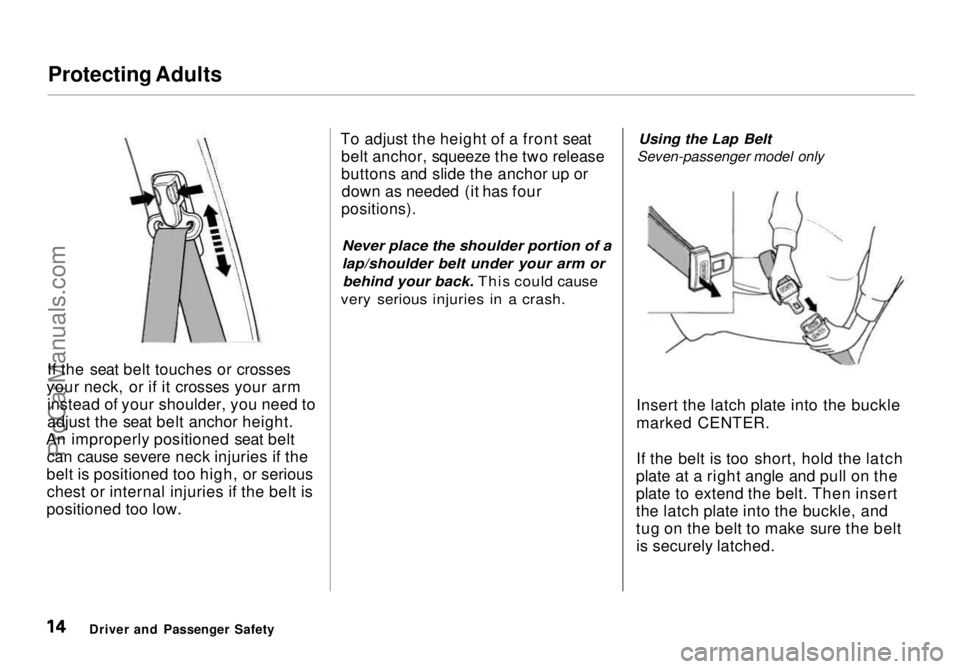
Protecting Adults
If the seat belt touches or crosses
your neck, or if it crosses your arm instead of your shoulder, you need to
adjust the seat belt anchor height.
An improperly positioned seat belt can cause severe neck injuries if the
belt is positioned too high, or serious chest or internal injuries if the belt is
positioned too low. To adjust the height of a front seat
belt anchor, squeeze the two release
buttons and slide the anchor up ordown as needed (it has four
positions).
Never place the shoulder portion of a
lap/shoulder belt under your arm orbehind your back. This could cause
very serious injuries in a crash.
Using the Lap Belt
Seven-passenger model only
Insert the latch plate into the buckle
marked CENTER.
If the belt is too short, hold the latch
plate at a right angle and pull on the
plate to extend the belt. Then insert
the latch plate into the buckle, and
tug on the belt to make sure the belt is securely latched.
Driver and Passenger SafetyProCarManuals.comMain Menu Table of Contents s t
Page 28 of 272
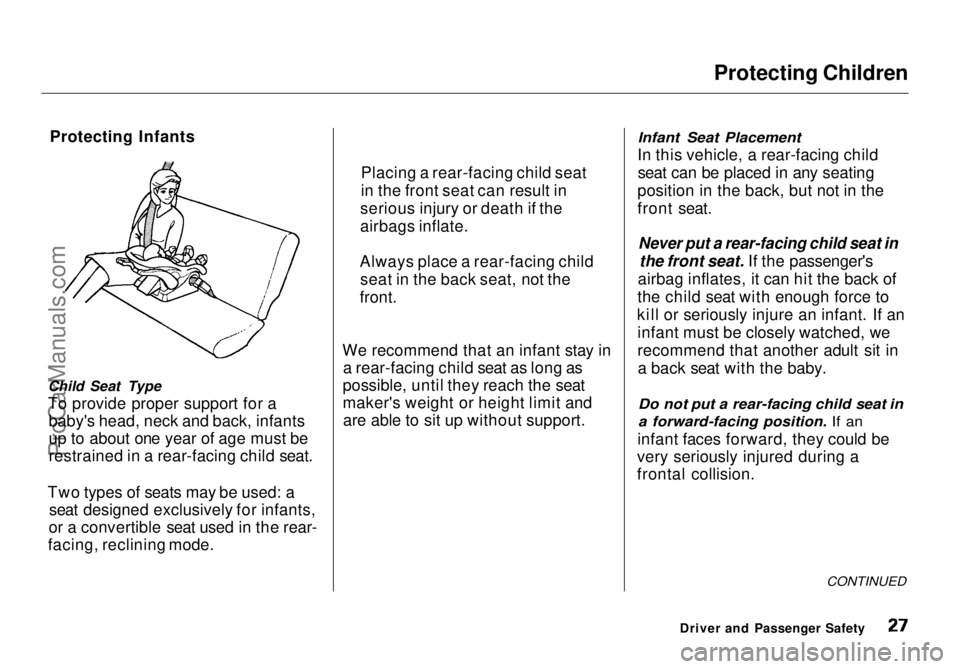
Protecting Children
Protecting Infants
Child Seat Type
To provide proper support for a baby's head, neck and back, infants
up to about one year of age must be
restrained in a rear-facing child seat.
Two types of seats may be used: a seat designed exclusively for infants,
or a convertible seat used in the rear-
facing, reclining mode. We recommend that an infant stay in
a rear-facing child seat as long as
possible, until they reach the seat
maker's weight or height limit and are able to sit up without support.
Infant Seat Placement
In this vehicle, a rear-facing child seat can be placed in any seating
position in the back, but not in the
front seat.
Never put a rear-facing child seat in
the front seat. If the passenger's
airbag inflates, it can hit the back of
the child seat with enough force to
kill or seriously injure an infant. If an infant must be closely watched, we
recommend that another adult sit ina back seat with the baby.
Do not put a rear-facing child seat in
a forward-facing position. If an
infant faces forward, they could be
very seriously injured during a
frontal collision.
CONTINUED
Driver and Passenger Safety
Placing a rear-facing child seat
in the front seat can result in
serious injury or death if the
airbags inflate.
Always place a rear-facing child seat in the back seat, not the
front.ProCarManuals.comMain Menu Table of Contents s t
Page 32 of 272
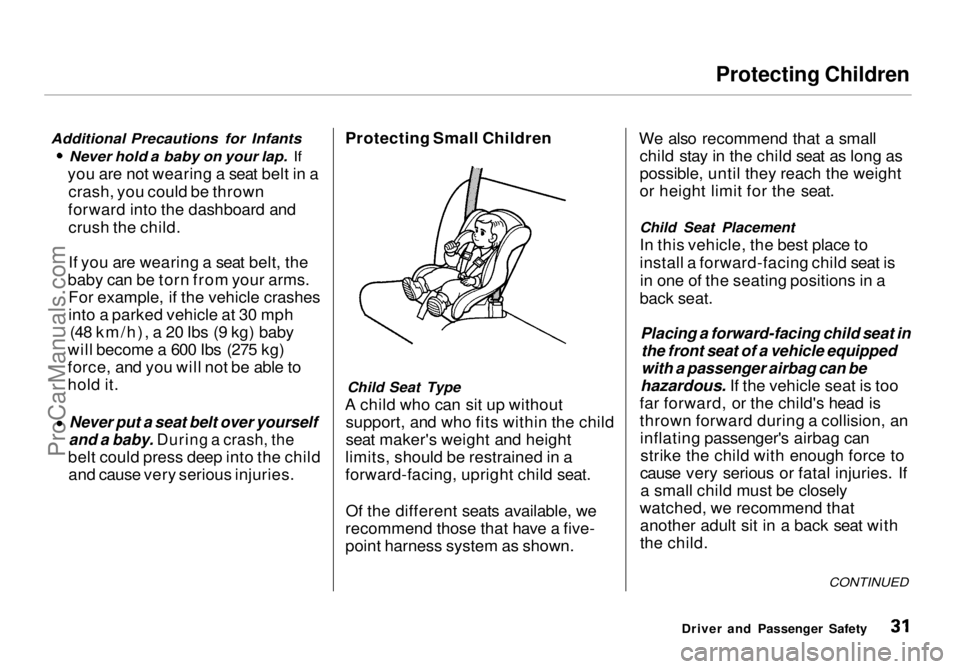
Protecting Children
Additional Precautions for Infants Never hold a baby on your lap. If
you are not wearing a seat belt in a crash, you could be thrown
forward into the dashboard and crush the child.
If you are wearing a seat belt, the
baby can be torn from your arms. For example, if the vehicle crashes
into a parked vehicle at 30 mph (48 km/h), a 20 Ibs (9 kg) baby
will become a 600 Ibs (275 kg)
force, and you will not be able to
hold it.
Never put a seat belt over yourself
and a baby. During a crash, the
belt could press deep into the child and cause very serious injuries. Protecting Small Children
Child Seat Type
A child who can sit up without support, and who fits within the child
seat maker's weight and height
limits, should be restrained in a
forward-facing, upright child seat.
Of the different seats available, we
recommend those that have a five-
point harness system as shown. We also recommend that a small
child stay in the child seat as long as
possible, until they reach the weight
or height limit for the seat.
Child Seat Placement In this vehicle, the best place to
install a forward-facing child seat is in one of the seating positions in a
back seat.
Placing a forward-facing child seat inthe front seat of a vehicle equipped
with a passenger airbag can be
hazardous. If the vehicle seat is too
far forward, or the child's head is
thrown forward during a collision, an inflating passenger's airbag canstrike the child with enough force to
cause very serious or fatal injuries. If a small child must be closely
watched, we recommend that another adult sit in a back seat with
the child.
Driver and Passenger Safety
CONTINUEDProCarManuals.comMain Menu Table of Contents s t
Page 36 of 272
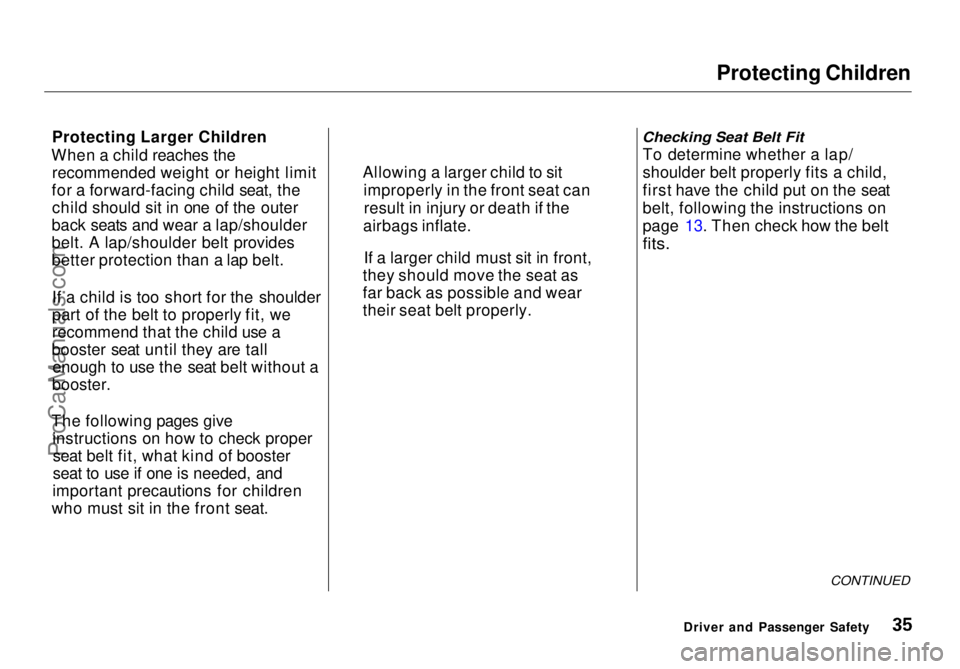
Protecting Children
Protecting Larger Children
When a child reaches the recommended weight or height limit
for a forward-facing child seat, the child should sit in one of the outer
back seats and wear a lap/shoulder
belt. A lap/shoulder belt provides
better protection than a lap belt.
If a child is too short for the shoulder
part of the belt to properly fit, we
recommend that the child use a
booster seat until they are tall enough to use the seat belt without a
booster.
The following pages give instructions on how to check properseat belt fit, what kind of booster
seat to use if one is needed, and
important precautions for children
who must sit in the front seat.
Checking Seat Belt Fit
To determine whether a lap/
shoulder belt properly fits a child,
first have the child put on the seat
belt, following the instructions on
page 13. Then check how the belt
fits.
CONTINUED
Driver and Passenger Safety
Allowing a larger child to sit
improperly in the front seat canresult in injury or death if the
airbags inflate.
If a larger child must sit in front,
they should move the seat as
far back as possible and wear
their seat belt properly.ProCarManuals.comMain Menu Table of Contents s t
Page 38 of 272
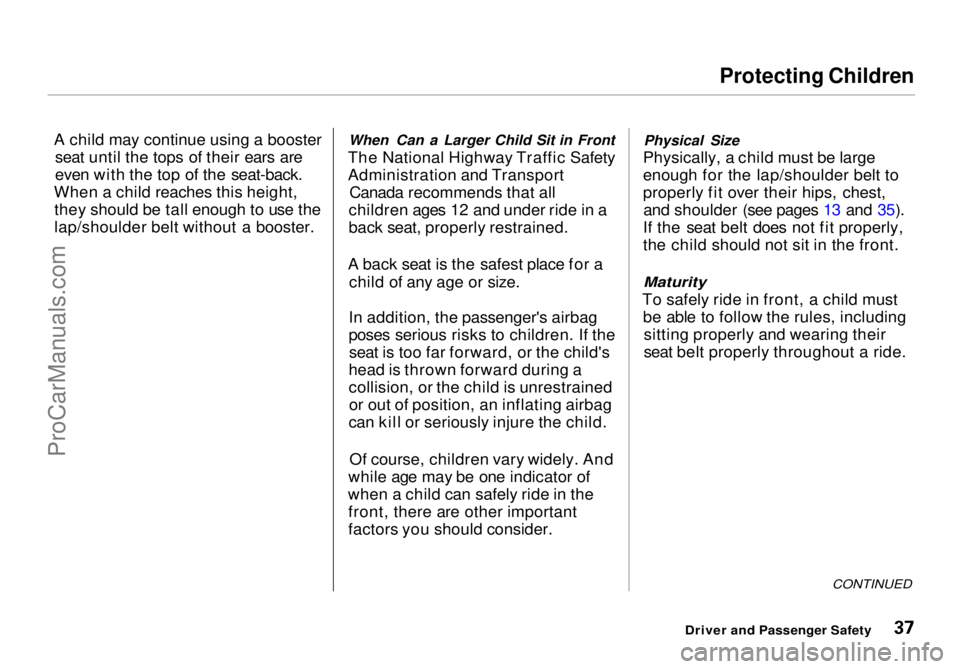
Protecting Children
A child may continue using a booster seat until the tops of their ears are
even with the top of the seat-back.
When a child reaches this height, they should be tall enough to use the
lap/shoulder belt without a booster. When Can a Larger Child Sit in Front
The National Highway Traffic Safety
Administration and Transport Canada recommends that all
children ages 12 and under ride in a
back seat, properly restrained.
A back seat is the safest place for a child of any age or size.
In addition, the passenger's airbag
poses serious risks to children. If the seat is too far forward, or the child's
head is thrown forward during a
collision, or the child is unrestrained or out of position, an inflating airbag
can kill or seriously injure the child.
Of course, children vary widely. And
while age may be one indicator of
when a child can safely ride in the front, there are other important
factors you should consider. Physical Size
Physically, a child must be large
enough for the lap/shoulder belt to
properly fit over their hips, chest, and shoulder (see pages 13 and 35).
If the seat belt does not fit properly,
the child should not sit in the front.
Maturity
To safely ride in front, a child must be able to follow the rules, includingsitting properly and wearing their
seat belt properly throughout a ride.
CONTINUED
Driver and Passenger SafetyProCarManuals.comMain Menu Table of Contents s t
Page 50 of 272

Instruments and Controls
This section gives information about
the controls and displays thatcontribute to the daily operation of
your Honda. All the essential
controls are within easy reach.
Control Locations............................ 50
Indicator Lights................................ 51
Gauges.............................................. 54
Tachometer.................................. 54
Trip Meter.................................... 54
Speedometer................................ 55
Odometer...................................... 55
Temperature Gauge.................... 55
Fuel Gauge................................... 55
Maintenance Required
Indicator.................................... 56
Controls Near the Steering
Wheel........................................ 57
Headlights.................................... 58
Daytime Running Lights............. 58
Instrument Panel Brightness..... 59
Turn Signals................................. 59
Windshield Wipers...................... 60
Windshield Washers................... 61
Rear Window Wiper and
Washer...................................... 61
Hazard Warning........................... 61
Rear Window Defogger.............. 62
Steering Wheel Adjustment....... 62
Steering Wheel Controls ................ 64
Cruise Control.............................. 64
Keys and Locks................................ 67
Keys............................................... 67
Immobilizer System..................... 68
Ignition Switch............................. 69
Power Door Locks....................... 70
Remote Transmitter.................... 71
Childproof Door Locks............... 72
Tailgate......................................... 72
Glove Box..................................... 73
Seats.................................................. 74
Passenger Seating....................... 74
Seat Adjustments......................... 74
Driver's Seat Power Height
Adjustment............................... 75
Armrests....................................... 76
Head Restraints........................... 76
Third Seat Access........................ 77
Removing the Second Seats
in the Six-Passenger Model.... 78
Folding the Second Seats
in the Seven-Passenger
Model.................................... 78
Reclining the Second Seat.......... 79
Folding the Third Seat
in All Models............................ 80
Power Windows............................... 82
Sunroof.............................................. 83
Mirrors.............................................. 84
Adjusting the Power Mirrors..... 84
Parking Brake.................................. 85
Digital Clock..................................... 86 Beverage Holder.............................. 86
Dashboard Compartment............... 88
Center Pocket.................................. 88
Vanity Mirror................................... 88
Cigarette Lighter............................. 89
Ashtrays............................................ 89 Interior Lights.................................. 90
Ceiling Lights............................... 90
Spotlights...................................... 90
Tailgate Light............................... 91 Courtesy Lights........................... 91
Instruments and ControlsProCarManuals.comMain Menu s t
Page 76 of 272
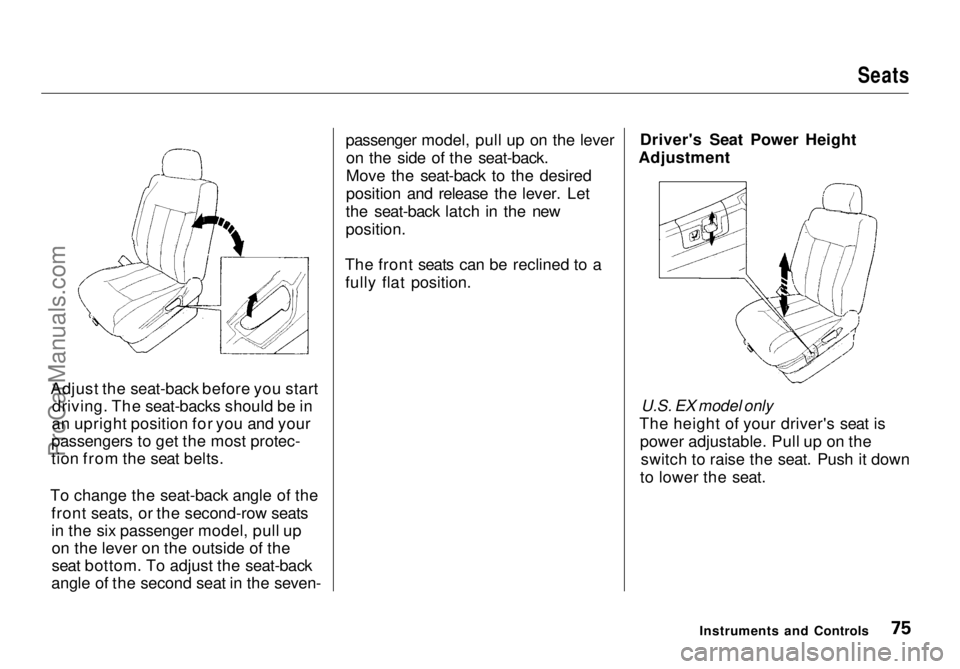
Seats
Adjust the seat-back before you start driving. The seat-backs should be in
an upright position for you and your
passengers to get the most protec-
tion from the seat belts.
To change the seat-back angle of the front seats, or the second-row seats
in the six passenger model, pull upon the lever on the outside of the
seat bottom. To adjust the seat-back
angle of the second seat in the seven- passenger model, pull up on the lever
on the side of the seat-back.
Move the seat-back to the desired
position and release the lever. Let
the seat-back latch in the new
position.
The front seats can be reclined to a fully flat position. Driver's Seat Power Height
Adjustment
U.S. EX model only
The height of your driver's seat is power adjustable. Pull up on theswitch to raise the seat. Push it down
to lower the seat.
Instruments and ControlsProCarManuals.comMain Menu Table of Contents s t
Page 77 of 272
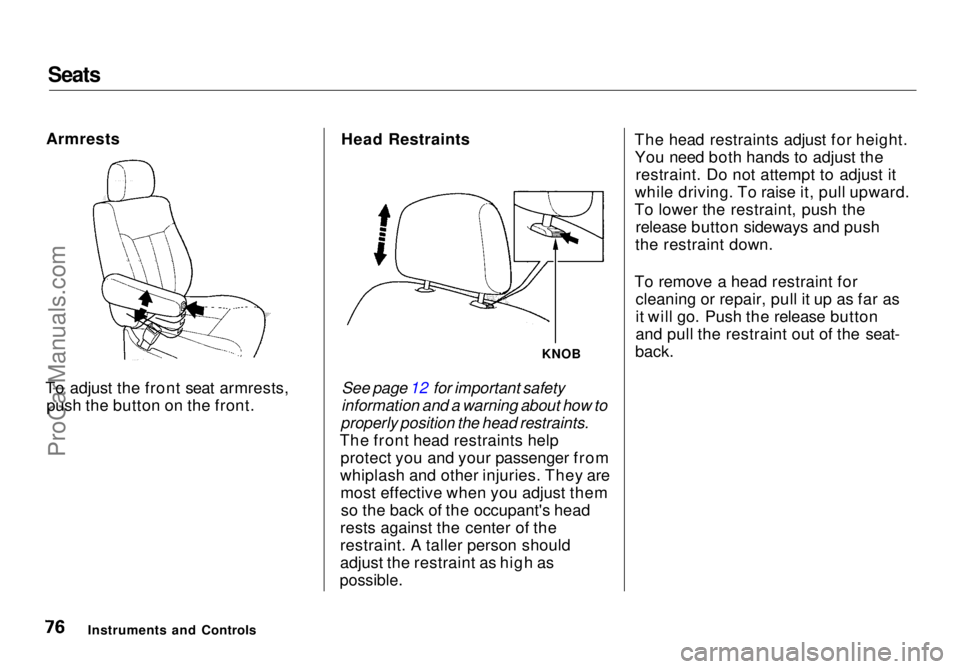
Seats
Armrests
To adjust the front seat armrests, push the button on the front. Head Restraints
See page 12 for important safety
information and a warning about how to
properly position the head restraints.
The front head restraints help protect you and your passenger from
whiplash and other injuries. They are most effective when you adjust themso the back of the occupant's head
rests against the center of the
restraint. A taller person should
adjust the restraint as high as
possible.
The head restraints adjust for height.
You need both hands to adjust the restraint. Do not attempt to adjust it
while driving. To raise it, pull upward.
To lower the restraint, push the release button sideways and push
the restraint down.
To remove a head restraint for cleaning or repair, pull it up as far as
it will go. Push the release button
and pull the restraint out of the seat-
back.
Instruments and Controls
KNOBProCarManuals.comMain Menu Table of Contents s t